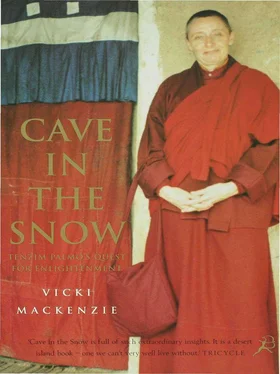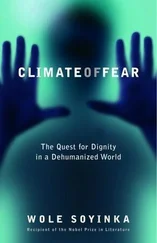Now the Karmapa took the earthly replica out of its box, held it up in the air, and placed it on his head. Simultaneously he built up in his mind the true black hat while reciting the mantra of Chenrezig, the Buddha of compassion, ‘Om Mani Padme Hung’. Tenzin Palmo, sitting at the Karmapa’s feet, was suddenly overcome. ‘I was already worked up emotionally and now tears of absolute devotion began streaming down my face. When it was over everyone went up for a blessing but I couldn’t move. I was empty. People left and I still sat there. The Karmapa put his hands out to me, I got up and went to him. He put both hands on my head and gave me his blessing.’
The next day she went to look at the old Rumtek monastery, once belonging to the Karmapa, now deserted. In one room there was a hole in the bricks and for some reason, totally unwise in a subtropical place like Sikkim, Tenzin Palmo had an urge to plunge her hand into it. She pulled out a bone artefact made of beautifully carved pieces, strung together like a net. It was identical to the garment worn by the powerful female tantric deity Vajrayogini. Having taken the vow ‘not to take anything that was not freely given’, however, Tenzin Palmo dutifully put it back. Later, when she told Khamtrul Rinpoche about it, he told her that she should have kept it. ‘It was for you,’ he said.
Undoubtedly the greatest highlight of all during those dark days in Dalhousie was meeting the Togdens. They were fascinating characters. With their dreadlocks and scruffy white skirts they looked like Eastern Rastafarians. In reality, however, they were ordained monks, the elite yogis of Khamtrul Rinpoche’scommunity. Traditionally, they always numbered thirteen, although in Dalhousie there were only seven. Selected from childhood for the purity of their intention, they were removed from the rest of the monks to undergo the most rigorous and most secret of trainings. Their mystic feats were legendary. One of their forebears, called Amkha Dechen Dorje, who happened to be married with children, managed to dematerialize not just himself but his entire family as well, plus his yaks, sheep, goats and dogs – an assembly of some sixty-two individuals. According to the story, Amkha went first to the Pure Land playing his damaru, followed by his wife, his children and finally his animals.
Among the present community there were still some remarkable men. Back in Tibet one old Togden, Atrin, had meditated on the edge of a precipice to stop himself from falling asleep. He had lived for years on just water and tsampa, and when that ran out had salvaged what was left over from a leopard’s kill. One day the leopard caught him picking up the bits of a deer and had chased him. Atrin, realizing how attached he still was to food, had dropped the meat and returned to his cave to continue meditating on an empty stomach.
For a year Tenzin Palmo lived with these remarkable men in her own room in one of the houses of their compound. At night they would sit out in the cold, damp air, their bodies wrapped in wet sheets, learning to dry them through the force of raising the mystic inner heat, tumo. She heard them leaping in the air and crossing their legs in the full lotus position before landing in the ground. She heard their chants. Out of all the monks, the Togdens alone treated Tenzin Palmo as one of their own.
‘Once I went to look for them and found them together in a room completely naked, preparing for some ritual. “Come in! Come in, Ani-la!" they called, completely unabashed. I backed out quickly and closed the door. On another rare occasion when I was invited to join an intiation I was making my way to the back of the temple when one of the Togdens called me to the front row to sit next to him on his tigerskin rug. I sat there for hours not moving, trying to be like the Togdens, but getting very cold. Suddenly I felt this warmth – the Togden next to me had put his long dreadlocks over my lap, covering me in a blanket of his hair.
‘I used to worry about their hair – thinking it must have been full of lice. When I said that to one of them they bent down and let me look at it – it was completely clean! When they used to go swimming in the river it would fall like ropes to their feet and the little monks would get hold of it and swing round on it, playing with it like maypoles.’
’They told me that in Tibet when they were chosen to be Togdens and taken up to the caves they were so excited because they felt that now they were going to become yogis. But for the first three years they were instructed to do nothing but watch their mind and practice Bodhicitta, the altruistic mind. They did that and nothing else for three years! They said it was in those three years that their minds transformed. After that, all the many practices they did were just building up on that foundation. One time one of them said to me: “You think we yogis are doing some very high, fantastic, esoteric practice and if only you had the teachings you also could really take off! Let me tell you, however, that there is nothing I am doing that you have not been taught. The only difference is that I am doing it and you aren’t,"’ she recalled.
’The amazing thing about these yogis is that they are so ordinary,’ Tenzin Palmo continued. ‘There’s no ego there. They are wonderful people, totally unjudgemental, totally unpretentious, absolutely un-self-regarding and the easiest people in the world to be with. Their minds are so vast. One time someone had sent me a tape of Gregorian chants and I put it on very softly so as not to disturb them. After ten minutes there was a knock on the door. It was one of the Togdens. “Could you turn it up because I can’t hear it,” he said. And then after he’d listened for a while he asked, “Is that Christian puja?” When I replied that it was he commented rather wistfully, “We don’t sound like that, do we?” After that he used to come in and play it by himself.’
Living in close and intimate proximity with the Togdens, the natural instinct to look after a man that she had surpressed after declining her Japanese boyfriend’s proposal now resurfaced. ‘I picked up their clothes, washed them and tried to mend them.I was so badly wanting to serve and their clothes were in such a dreadful state. They had no money and didn’t own anything. But they were having none of it. They were horrified at the amount of time it took and wouldn’t let me continue.’
It was, however, the first lesson the Togdens taught Tenzin Palmo that left the strongest impression on her. ‘If anyone asks you what realizations you have gained you reply “Nothing",because compared to the Buddhas it is nothing. And, in any case, the more you realize the more you realize there is nothing to realize,’ they told her. It was advice she was to remember always.
One day Tenzin Palmo heard of Togdenmas, the women equivalent of the Togdens, and her heart rose. She learnt that there had been a community of Togdenmas associated with the Khamtrul Rinpoches in Kham, who lived in secret places practising their spiritual skills with outstanding success. It was said that even when they were old they looked like women in their early thirties, a sign of their spiritual powers. Sadly, like most of the treasures of Tibet, the Togdenmas had disappeared in the revolutionary zeal of the Cultural Revolution, no one knowing what had become of them. But what Tenzin Palmo did learn excited her greatly.
‘I heard that they had this long hair which they used to hang over ropes when they assembled together to do their pujas. The men were not allowed to join them and could only look at them from a gallery above. They were extremely powerful. The Togdens said that if I had seen the Togdenmas I wouldn’t even look at them,’ Tenzin Palmo said. ‘I knew that was what I wanted to be. I rushed to Khamtrul Rinpoche to ask him. He was delighted. “In Tibet I had many Togdenmas,” he said, “but now I don’t have even one. I pray that you will become an instrument in re-establishing the Togdenma lineage."’
Читать дальше












